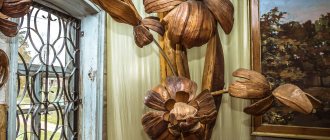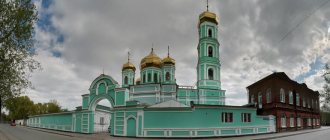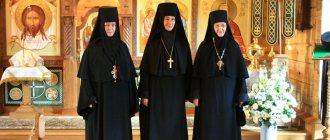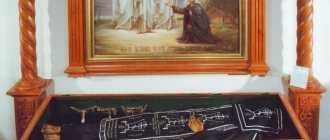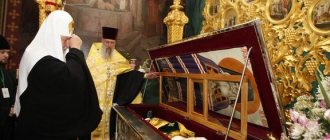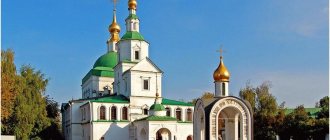The Holy Trinity Ipatiev Monastery in Kostroma, picturesquely located at the confluence of the Kostroma River and the Volga, is an ancient monument, an object of cultural heritage of our Fatherland. This monastery is rightly called the “cradle” from which the Romanov dynasty emerged - it was where young Mikhail Romanov was when the procession of the Grand Embassy headed here with the news that the people had chosen him as the new tsar. With this in mind, each new heir to the throne, when becoming a sovereign, did not skimp on real royal gifts for the Ipatiev Monastery.
Moreover, the Romanovs gifted the monastery not only with gold and silver, but also with rare books, icons, and objects of art. To this day, many valuable church relics and other significant historical exhibits are kept in the monastery museum. The monastery is revered by pilgrims who come here to venerate its shrines; it is also of interest to travelers who want to touch the history of the country.
Ipatiev Monastery in Kostroma on Google panorama:
Tatar founder of the Russian monastery
The monastery was founded in 1330 at the expense of the Tatar Murza Chet. A native of the Golden Horde, the noble Tatar nobleman Murza Chet, voluntarily went into the service of the Great Moscow Prince Ivan Danilovich Kalita.
While crossing the Volga, Murza became seriously ill and pitched a tent for rest and treatment at the mouth of the Kostroma River at its confluence with the Volga. In a dream, the Most Holy Theotokos appeared to the nobleman with the Apostle Philip and the Great Martyr Hypatius of Gangra . The Mother of God promised to heal Chet if he accepted Christianity and built a monastery in honor of Saint Hypatius.
Arriving in Moscow, Murza converted to Christianity, receiving the name Zacharias at baptism, and asked the Grand Duke for permission to found a monastery at the site of his healing. Through the diligence of the Tatar Murza, on the banks of the Kostroma River, in gratitude to God, a monastery was founded in honor of the Great Martyr Hypatius.
How to get there[edit]
Address
: 156004, Kostroma, st. Prosveshcheniya, 1
Directions:
- By car, the road from the capital to Kostroma takes 4.5-5 hours (346 km) and passes along the Yaroslavl highway and the M 8 highway (Kholmogory). In Kostroma, you need to cross the road bridge to the left bank of the Volga and turn onto the street. Soviet. Along it, Tekstilshchikov Avenue and st. Ostrovsky, you should drive up to the road bridge over a tributary of the Volga - the Kostroma River. Ipatievskaya Sloboda is located on the right bank of the Kostroma River, and Beregovaya Street leads to it.
- By train or bus. From Yaroslavsky Station in Moscow to Kostroma, trains take 6.04-6.35 hours. In addition, from the capital's Central Bus Station, located near the Shchelkovskaya metro station, Kostroma can be reached by regular buses (7 trips per day). This journey takes 6.5 hours. The Kostroma bus station is 1 km away from the railway station. From the city bus station to the monastery there is a bus and route taxi No. 14. Also, route buses No. 4, 8, 11 and 38 go to Ipatievskaya Sloboda.
Phones:
+7 (4942) 37-22-41 (secretary), +7 (4942) 31-25-89 (pilgrimage department), +7 (4942) 31-75-91 (museum)
Email:
,
Monastery patronized by the Godunovs
In the fifth generation of the Chet family - Zacharias - two brothers were born: Fyodor Ivanovich Sabur and Ivan Ivanovich Godun, the founders of the famous families of the Saburovs and Godunovs. Since the rise of the Godunov family, descendants of the legendary Murza, the monastery began to flourish. By the end of the 16th century, through their efforts, the monastery became the center of the political and spiritual life of medieval Rus'. The abbot of the monastery, Abbot Iakov, was consecrated to the rank of archimandrite in 1599.
Impregnable fortress
The Ipatiev Monastery during the time of the Godunovs was an impregnable fortress. The monastery was surrounded by high oak walls, in the center of the courtyard there was a temple consecrated in the name of the Life-Giving Trinity. In the 16th century, stone walls, cathedrals, belfries and cells were built here. The ancient fortress walls amaze with their power.
The monastery was surrounded by earthen ramparts, the thickness of the walls was 3 meters, the height was from 6 to 11. The stone fence, impregnable from the outside, had archery towers on the inside, where large guns were installed.
Gunpowder was stored in a special Powder Tower , and in the Water Tower there was a secret exit to the Kostroma River. The walls and towers are connected on the inside by wide passages. So the monastery became a fortress at the entrance to the city along the Yaroslavl road.
Ancestral tomb
The Godunovs took monastic vows and lived out their lives in the Ipatiev Monastery, wishing to rest in the family tomb - “coffin chambers” , inside of which hung family images in precious vestments. On the tombstones lay covers embroidered with gold, silver and pearls, and lamps burned in front of the images.
Three tombs with 52 burials were formed on the territory of the monastery. The soil of the Ipatiev Monastery still contains the ashes of the famous Godunov family, who were supported by the constant prayer of the monastery brethren, interrupted in 1919 due to the closure of the monastery. The Godunovs – collectors and donors of priceless antiquities
Dmitry Ivanovich Godunov started the tradition of a priceless collection of antiquities in the monastery. Oprichnik of Tsar Ivan the Terrible, Dmitry Godunov is a connoisseur and connoisseur of beauty, a man with a subtle artistic taste. In his home workshop, the best icon painters, jewelers and miniature masters of the Moscow Kremlin created works of amazing perfection.
The temple doors of the first “Godunovsky” stone cathedral were made in the 16th century by order of Dmitry Godunov in the workshops of the Moscow Kremlin and were made using the rare technique of gold touching on copper. The doors are covered with copper sheets depicting biblical prophecies and gospel stories.
A gold frame for the temple image of the Holy Trinity, a gold set of theological vessels and holy bowls, funeral dishes, tapestries and jewelry - Dmitry Ivanovich’s contributions to the Trinity Cathedral emphasize his intention to elevate the ancient ancestral monastery. Items of church utensils: a massive chalice, paten, spear and spoon are made of gold and decorated with chased images.
With the support of the Godunovs, a workshop operated that produced handwritten books with magnificent decoration. Dmitry Godunov's book contributions are priceless: altar Gospels, Psalms, Missals, made by Moscow craftsmen, decorated with precious frames, obverse miniatures with elegant pearl ornaments.
The Ipatiev Monastery kept the Gospel of 1605 , equipped with illustrations, decorated with blue and gold headpieces and miniatures.
Among them is the composition “Family Tree of Jesus Christ,” which includes the biblical “ancestors” of Christ in medallions and “The Nativity of Christ.” Written in semi-character, the Gospel is kept in the Armory Chamber of the Moscow Kremlin.
Excursions
Visitors have access to the territory of the Old Town of the monastery, where the architectural and museum complex is located. There is an entrance fee, 170 rubles for adults. You can explore the exhibitions of the Ipatiev Monastery Museum on your own or pay for a tour. During your visit to the monastery, you can get acquainted with its architectural ensemble, the painting of the Trinity Cathedral and the main shrines. Several expositions and exhibitions have been created that tell about the history of the landmark and its significance in the fate of the country.
One of the exhibitions introduces the history of the Romanovs’ ascension to the throne, their connection with the Kostroma region and the monastery. A separate exhibition is dedicated to the last Romanov on the throne - Nicholas II, and the martyrdom of him and his family. Another exhibition introduces the work of the talented Kostroma icon painter and isographer Guriy Nikitin. The museum also displays a collection of icons, items of church utensils, and it is interesting to visit the Romanov chambers, which contain many interesting artifacts - antiques and things donated to the monastery by monarchs.
If you are not interested in museum collections and would like to attend only religious services, then it is important to know that they take place from 5:00 to 9:00 and from 17:00 to 19:00, and admission is free.
View of the monastery, © Eduard Skvortsov
Cradle of the Imperial House of Romanov
With high patronage, the monastery flourished, owning hundreds of villages and huge plots of land.
Troubled times
In 1605, the Godunovs were removed from government, and the Great Troubles began. A series of palace coups, when power changed hands, accompanied by bloodshed and betrayal, ended in the Ipatiev Monastery, which became the place where the course of Russian history changed.
After wars and strife, the time has come for unity and national harmony. On February 8, 1612, Moscow was liberated from Polish dominance, and in February 1613, the Zemsky Sobor elected 16-year-old Mikhail Fedorovich Romanov to the Russian throne. The era of the Imperial House of Romanov begins.
The beginning of change
Under Boris Godunov, the Romanovs lived in exile in the Ipatiev Monastery. During the meeting of the Zemsky Sobor, the chosen one was in the Kostroma estate of the village of Domnino. A great embassy was sent from Moscow to Kostroma to express the will of the people to the newly elected monarch.
The Poles, having learned about the election of Mikhail, decided to capture him, but the Kostroma peasant Ivan Osipovich Susanin, at the cost of his own life, saved the new dynasty, luring the Poles into an impassable thicket. On the central square of modern Kostroma stands a monument to a fearless fellow countryman.
When the Poles dealt with Ivan Susanin, Mikhail and his mother took refuge in the Ipatiev Monastery, where the embassy arrived on the 12th day of the movement from Moscow. On March 14, 1613, the ambassadors of the Zemsky Sobor for a long time, but in vain, asked young Mikhail and his mother Martha to accept the election. After 6 hours of exhortation, the young chosen one, with tears, agreed to take the Russian throne.
The recent events of the Time of Troubles frightened young Mikhail; there was no one to protect him: his father, Archimandrite Philaret, was captured by the Poles. The ambassadors convinced the sovereign to rely “on the righteous and incomprehensible destinies of God.” Miraculous images brought from Kostroma were used to perform the solemn ceremony of calling Mikhail Fedorovich Romanov to the kingdom. Thus came the end of the Time of Troubles in Rus'.
Since then, members of the royal family revered the Ipatiev Monastery as a family shrine. Upon ascending the throne, each of the kings, visiting the monastery, made generous contributions. A contribution is a donation to the monastery to hire monastic prayer for the salvation of the soul. Bells were highly valued as a contribution.
Numerous royal charters strengthened the economic position of the monastery. At the behest of Mikhail Romanov, the territory of the monastery was doubled, the towers and walls looked elegant and rich, stone housing, abbots’ and brethren’s cells, cellars, a cookhouse, and a refectory were built.
The length of the monastery walls, fortified with square towers, increased to 518 meters, the height of the walls - to 10. In terms of the size of land holdings, the monastery occupied fourth place among the largest Russian monasteries.
Prosperity of the monastery
The powerful patrons of the Romanov monastery did not skimp, donating funds for repairs and construction of new buildings, the development of artistic icon painting and stone carving. As a sign of special royal favor to the Trinity Monastery of the Ipatiev Monastery from Moscow, Tsar Mikhail Fedorovich transferred the Tikhvin image of the Mother of God and sent the Royal Seat.
The love of Kostroma residents for the Tikhvin Icon is so great that during the procession on the day of veneration of the miraculous Theodore Icon of the Mother of God, the Tikhvin Icon is also taken out of the monastery and paraded with it throughout the city.
In 1744, the Kostroma bishop's residence , and the Trinity Cathedral received cathedral status. The ancient monastery turned into the administrative center of the Kostroma diocese. Construction work resumed at the monastery and the Bishop's Garden was laid out.
In the 18th century, a new gate was built in honor of the arrival of Empress Catherine II in Kostroma. For the construction of the front gate, drawings of the Empress's carriage were delivered to Kostroma with the requirement that they be made so that the carriage could pass freely through the gate. The main entrance greeted Catherine with dignity, solemnly welcoming her with a high pediment depicting the empress’s monogram.
Celebrating the anniversary of the House of Romanov
In 1913, the Ipatiev Monastery became the center of the celebration of the 300th anniversary of the Reigning House of Romanov. The royal family, led by Nicholas II and courtiers, arrived for the celebration in Kostroma. The ancient monastery appeared before the guests in its splendor.
The Ipatiev Monastery, surrounded by high walls, with loopholes and watchtowers, was a formidable fortress. The golden domes of the cathedral against the backdrop of shaggy cedars, fluffy larches and weeping birches brought solemnity and sparkled festively in the sun.
On the eve of the celebration, the Trinity Cathedral was overhauled and the base was covered with white stone. Among the huge crowd of people greeting the Tsar were the descendants of Ivan Susanin, whose ashes, at the behest of Mikhail Romanov, were buried in the Ipatiev Monastery. A religious procession took place through the city, in which all the clergy of Kostroma participated.
The Emperor venerated the Feodorovskaya Icon of the Mother of God , which was used to bless the reign of his ancestor Michael, and entered the monastery. In the Trinity Cathedral, the sovereign defended the Liturgy and prayer service. The king went out to the people who had blocked the place between the monastery and the bank of the Kostroma River.
There was nothing similar to the celebrations that took place on May 19, 1913 in the history of the monastery. The solemn event became the apotheosis of the ancient monastery and at the same time a farewell to the departing old Russia. The revolutionary events of 1917 put forward new values, among which there was no place for either monasteries or national shrines.
Ruined monastery and new life
In 1919, the Ipatiev Monastery was closed, and a terrible atheistic period began.
Soviet era
The monastery housed an orphanage and a dormitory for textile workers, military barracks, and a stadium and dance floor. The provincial commission confiscated sacred vessels, lamps, candlesticks, and frames for icons weighing 14 kg. gold and 200 kg. silver
In 1958, the Soviet government awarded the monastery the status of a museum-reserve . Restoration began in the monastery, which lasted 20 years.
Rebirth time
The day of the revival of the Ipatiev Monastery is November 25, 1989, when Bishop Alexander held the first service in many decades of destruction of the Church in the presence of the entire clergy of the city.
In 1991, the Holy Trinity Ipatiev monastic community , and a new life began in the monastery. Since that time, every year on the day of execution of representatives of the royal Romanov family, a funeral service is held in the Ipatiev Monastery.
In the summer of 1993, the monastery hosted the “Milestones” festival, dedicated to the 380th anniversary of the Romanov dynasty. On April 12, 1996, 6 new bells were installed on the belfry of the monastery. The largest, “Svet-bell”, weighs 65 pounds. At the end of 2004, the monastery was transferred to the Russian Orthodox Church.
Since 2004, the Church Historical and Archaeological Museum has been opened; its collection is based on unique objects of worship, exhibits of ancient writing and printing, valuable works of artistic heritage and ancient manuscripts, including the legendary Ipatiev Chronicle.
Monastic life
The monastery complex includes numerous towers, a gate church, a candle and bishop’s building, to which are adjacent the “chambers of the Romanov boyars.” For the 400th anniversary of the Romanov dynasty, in memory of the tragic end of the dynasty, the “Royal Golgotha” chapel was erected next to the monastery.
Nowadays, the high status of the Ipatiev Monastery - the official cradle of the Romanov dynasty - is emphasized by restored churches, neat paving stones of paths, a lush variety of flowers and evenly trimmed grass on the lawns. The monastery community lovingly landscapes the territory: there are two orchards here, neat bushes and lush trees highlight the cleanliness and order of the monastery courtyard.
The spiritual life of prayer is being revived in the monastery, without which other monastic activities will not be beneficial. The small brethren of the monastery support youth projects of the diocese and participate in the work of the diocesan media. The main obedience of the brethren is cell prayers, church services and work on the restoration of the Church of St. John the Theologian.
Architectural ensemble of the Ipatiev Monastery[edit]
- Trinity Cathedral Church (1650-1652)
- Church of the Nativity of the Blessed Virgin Mary (restored in 2015)
- Belfry (1603—1605)
- Bishop's building (XVIII century) with the Holy Gate and the gate church of the Great Martyrs Chrysanthos and Daria (mid-XIX century)
- Chambers of the Romanov boyars (XVI century, reconstruction mid-XIX century)
- Viceroyal Corps (XVI century, reconstruction mid-XIX century)
- Fraternal Corps (XVIII century)
- Cells above cellars (XVI-XVIII centuries)
- Refectory building (XVI-XVII centuries)
- Candle box (XIX century)
- Walls and towers of the Old Town (Kuznechnaya, Porokhovaya, Vodyanaya, Voskoboynaya, Kvasnaya) (XVI-XVII centuries)
- Walls and towers of the New City (XVII century)
Temples and bell tower
The gate church in honor of the martyrs Chrysanthus and Daria was erected in 1841 on the site of the entrance to the monastery. Chrysanthus and Darius suffered for the Christian Church in 283 in Rome. The Church of the Ipatiev Monastery is the only church in Russia dedicated to these martyrs.
The throne of the Church of the Holy Martyrs, commemorated on April 1, was consecrated in memory of the fact that on this day in 1613, Mikhail Fedorovich Romanov left the Ipatiev Monastery for Moscow to become king. On the same day in 1814, Emperor Alexander I, at the head of the Russian army, entered Paris after the victory over Napoleon.
The church is a pillarless temple , erected above the arch of the Holy Gate, crowned with a 12-sided tent with a small dome on a blind drum. The decor of the temple is a combination of elements of classicism and ancient Russian architecture. The church, where evening and morning services are held daily, was re-painted by a team of Palekh artists.
Trinity Cathedral was built under Tsar Alexei Mikhailovich in 1650-1652 on the site of the “Godunov” temple. The four-pillar, three-sided temple is crowned with five domes on light drums. Raised on a high basement, it is surrounded on three sides by two-tier galleries. At the end of the southern gallery is the chapel of St. Mikhail Malein, the namesake of the holy Tsar Mikhail Romanov.
The northern, richly decorated side of the temple is the facade of the building, the window openings of which are included in the composition of the columnar belt. There is also a front porch with an octagonal tent, raised on four decorative pillars with powerful pods and hanging arches with weights.
The Trinity Cathedral is decorated with a magnificent iconostasis of the mid-18th century: voluminous grape branches of Flemish carving, covered with thin sheets of gold leaf, made by Kostroma carvers in the Baroque style. The icons for the iconostasis were made by royal icon painters. Wall paintings from the 17th century with elegant ornamental decoration nobly highlight the skillfully executed icons.
The Church of the Nativity of the Blessed Virgin Mary is a spacious stone church with five domes in the Russian-Byzantine style with a chapel in the name of Saints Basil the Great, Gregory the Theologian and John Chrysostom. The church is decorated with a gilded iconostasis with icons made by Palekh icon painters.
The bell tower consists of two parts of different periods. The ancient part was erected in 1604 at the expense of the Godunovs in the style of a multi-span arcade. In 1645, a high bell tower with one open span for ringing and a tent with green tiles was added to it by order of Alexei Nikitich Godunov, the last representative of the famous family.
The bell tower is decorated entirely with stone carved belts, double semi-columns and window openings with a keeled finish. The western open gallery, built in place of the previous wooden one, was added in the 19th century. There were 18 bells on the belfry. The largest, weighing 600 pounds, is the contribution of Tsar Boris Godunov’s mother Stefanida.
In 2006, a new 500-pound bell “Tsar Michael” by Prince Michael of Kent, the great-great-great-grandson of Emperor Nicholas II, cast in memory of the 400th anniversary of the election of the Russian Tsar Mikhail Fedorovich Romanov to the throne of the state.
Next to the bell tower, on a pedestal, there is a removed hour bell, the contribution of Boris Godunov's uncle, Dmitry. Not far from the bell tower there is a memorial column in memory of significant events and persons who left their mark on the history of the Ipatiev Monastery.
The attraction of the monastery is the chambers of the Romanov boyars . Young Mikhail Romanov lived here when, in 1613, the embassy of the Zemsky Sobor arrived here with the news of the election of 16-year-old Mikhail to the Russian throne.
Location[edit]
It was first mentioned in the chronicle in 1432, but it may have been founded much earlier. The territory of the monastery consists of two parts: the Old and New Town. Both areas are surrounded by high stone walls. The old city has the shape of an irregular pentagon. The compositional center of the monastery is the monumental five-domed Trinity Cathedral; There is a belfry nearby.
In the post-war period, monuments of wooden architecture were brought to the walls of the monastery from all over the Kostroma region and an open-air museum was created. Behind it lies the Ipatievskaya Settlement, which in ancient times belonged to the monastery; the five-domed church of St. John the Evangelist (17th century) has been preserved there.
Shrines of the monastery
Priceless shrines are kept in the Ipatiev Church:
- The miraculous Tikhvin Icon of the Mother of God.
- Pieces of the Robe of the Lord.
- Particles of the relics of the Hieromartyr Hypatius, Bishop of Gangra.
- Part of the honest head of Christ for the sake of the holy fool Simon Yurievetsky.
- Stone from the execution room of the Ipatiev House.
The Tikhvin Icon of the Mother of God is a revered shrine of the Kostroma land. The icon is an exact copy of the miraculous Tikhvin icon, painted by St. Peter, Metropolitan of Moscow. It was first brought to Kostroma in 1613 by the embassy of the Zemsky Sobor, which announced to young Mikhail his election to the All-Russian royal throne.
In 1619, Tsar Michael donated the shrine to the monastery, where it remained in the iconostasis of the Trinity Cathedral. In 1919, removed from the church, it became inaccessible for worship. On April 13, 2004, the shrine returned to the Kostroma diocese, taking its historical place.
The majestic view of the Ipatiev Monastery, the solemn splendor and the ringing of church bells leave unforgettable feelings and emotions in the soul of a Russian person.
Patronal holidays
Trinity Day is considered one of the main Christian holidays and is celebrated on Sunday, Pentecost.
And:
- 03/29.08 – Theodore Icon of the Mother of God;
- 03 (1.04) – martyrs Chrysanthus and Daria;
- 03 (13.04) – St. Hypatia;
- 06 (9.07) – Tikhvin Icon of the Mother of God;
- 07 (17.07) – St. Royal Passion-Bearers (Tsar Nicholas and members of his family);
- 07 (25.07) – St. Mikhail Malein;
- 10 (30.10) – righteous Lazarus of the Four Days:
- Lazarus Saturday;
- 11 (27.11) – Apostle Philip.
